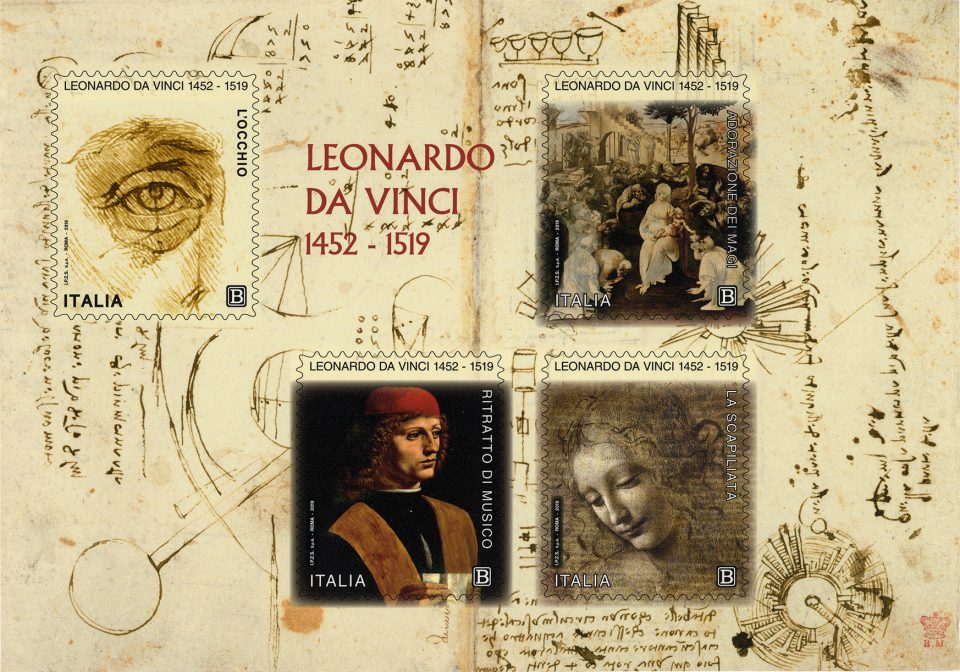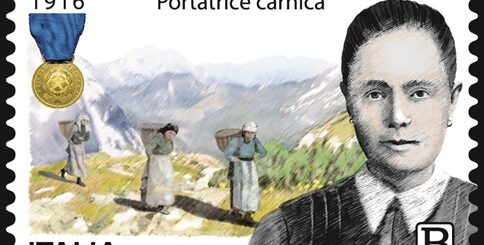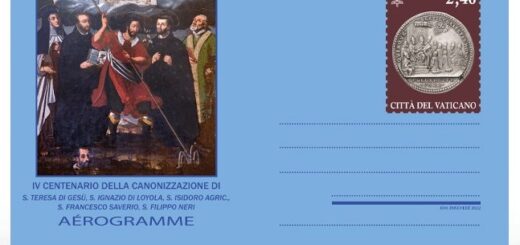POSTE ITALIANE 18^ emissione anno 2019 del 02 Maggio di un foglietto con n.4 francobolli dedicati a Leonardo da Vinci nel V centenario della scomparsa

Il Ministero dello Sviluppo ha emesso il 2 maggio 2019 un foglietto con n.4 francobolli commemorativi di Leonardo da Vinci , nel V centenario della scomparsa relativi al valore della tariffa B, ognuno pari ad € 1.10.
I quattro francobolli, racchiusi all’interno di un foglio, riproducono rispettivamente un’opera di Leonardo da Vinci, precisamente da sinistra a destra partendo dall’alto: particolare di Studi di proporzioni del volto e dell’occhio, Musei Reali – Biblioteca Reale di Torino; “Adorazione dei Magi”, Galleria delle Statue e delle Pitture degli Uffizi; “Ritratto di Musico”, Pinacoteca Ambrosiana; “Testa di fanciulla” detta “ La Scapiliata”, Galleria Nazionale di Parma.
- data/date 02 Maggio 2019
- dentellatura/serration 11
- stampa/printing fustellatura/rotocalco
- tipo di carta/paper type bianca patinata neutra
- stampato I.P.Z.S. Roma
- tiratura francobolli 300.000
- foglietti 300.000
- formato foglietto 185 x 130 mm
- dimensioni/dimension 40 X 48 mm
- costo/price B = €1.10 a francobollo/ a stamp
- num. catalog/ catalog num. Michel 4113-4114-4115-4116 YT 3874-3875-3876-3877 UN 3956-3957-3958-3959
Leonardo di ser Piero da Vinci (Anchiano, 15 aprile 1452 – Amboise, 2 maggio 1519) è stato un inventore, artista e scienziato italiano.
Uomo d’ingegno e talento universale del Rinascimento che incarnò in pieno lo spirito della sua epoca, portandolo alle maggiori forme di espressione nei più disparati campi dell’arte e della conoscenza, occupandosi di architettura e scultura,fu disegnatore, trattatista, scenografo, anatomista, musicista, progettista e inventore, al punto che è considerato uno dei più grandi geni dell’umanità.
Le origini e la famiglia
Leonardo fu il figlio primogenito nato da una relazione illegittima tra il notaio ventiquattrenne Piero da Vinci e Caterina, una donna di estrazione sociale modesta. La notizia della nascita del primo nipote fu annotata dal nonno Antonio, padre di Piero e anche lui notaio, su un antico libro notarile trecentesco. Nel registro non è indicato il luogo di nascita di Leonardo, che si ritiene comunemente essere la casa che la famiglia di ser Piero possedeva, insieme con un podere, ad Anchiano, dove la madre di Leonardo andrà ad abitare.
Il battesimo avvenne nella vicina chiesa parrocchiale di Santa Croce, ma sia il padre sia la madre erano assenti, poiché non sposati. Per Piero si stavano preparando ben altre nozze, mentre per Caterina fu cercato, nel 1453, un marito che accettasse di buon grado la sua situazione “compromessa”, trovando un contadino di Campo Zeppi, vicino a Vinci, tale Piero del Vacca da Vinci, detto l’Attaccabriga.
Periodo di formazione
Ser Piero aveva già lavorato a Firenze e nel 1462, a dire di Giorgio Vasari, vi ritornò con la famiglia, compreso il piccolo Leonardo. Il padre Piero avrebbe mostrato all’amico Andrea del Verrocchio alcuni disegni di tale fattura che avrebbero convinto il maestro a prendere Leonardo nella sua bottega; è in realtà alquanto improbabile che un apprendistato cominciasse ad appena dieci anni, per cui l’ingresso di Leonardo nella bottega del Verrocchio viene oggi ritenuto posteriore.
Si pensa infatti che Leonardo restasse in campagna nella casa dei nonni, dove avvenne la sua educazione, piuttosto disordinata e discontinua, senza una programmazione di fondo, a cura del nonno Antonio, dello zio Francesco e del prete Piero che l’aveva battezzato. Il fanciullo imparò infatti a scrivere con la sinistra e a rovescia, in maniera del tutto speculare alla scrittura normale.
Nella bottega del Verrocchio
Diventando ormai sempre più evidente l’interesse del giovane Leonardo nel “disegnare “, ser Piero mandò infine il figlio, dal 1469 o 1470, nella bottega di Andrea del Verrocchio, che in quegli anni era una delle più importanti di Firenze, nonché una vera e propria fucina di nuovi talenti. Tra gli allievi figuravano nomi che sarebbero diventati i grandi maestri della successiva generazione, come Sandro Botticelli, Perugino, Domenico Ghirlandaio e Lorenzo di Credi, e la bottega espletava un’attività poliedrica, dalla pittura alle varie tecniche scultoree (su pietra, fusione a cera persa e intaglio ligneo), fino alle arti “minori”. Soprattutto veniva stimolata la pratica del disegno, portando tutti i collaboratori a un linguaggio pressoché comune, tanto che ancora oggi può risultare molto difficile l’attribuzione delle opere uscite dalla bottega alla mano del maestro oppure a un determinato allievo. Si conoscono vari esempi di disegni di panneggi usciti dalla sua bottega, che derivano da esercizi che il maestro faceva fare copiando le pieghe dei tessuti sistemati su modelli di terra. Inoltre gli allievi apprendevano nozioni di carpenteria, meccanica, ingegneria e architettura.
Leonardo si trova menzionato nella Compagnia di San Luca, dei pittori fiorentini, nel 1472. Ciò significa che a quell’epoca era già riconosciuto come pittore autonomo, la cui esperienza formativa poteva dirsi conclusa, sebbene la sua collaborazione col maestro Verrocchio si protraesse ancora per diversi anni.
Il 5 agosto 1473 Leonardo datò il Paesaggio con fiume, un disegno con una veduta a volo d’uccello della valle dell’Arno, oggi al Gabinetto dei disegni e delle stampe degli Uffizi.
Il dipinto su tavola raffigurante Madonna con Bambino, detto comunemente Madonna di Camaldoli per la sua collocazione nell’eremo in provincia di Arezzo, è una elaborazione della Madonna Dreyfus .
Leonardo scultore
Vasari ricordò come Leonardo operò anche “nella scultura, facendo, nella sua giovanezza, di terra alcune teste di femmine che ridono, che vanno, formate per l’arte di gesso, e parimente teste di putti, che parevano usciti di mano d’un maestro”. Non si conosce tuttavia alcuna opera scultorea sicura di Leonardo.
Prime opere indipendenti
Le prime opere indipendenti di Leonardo vengono oggi datate tra il 1469 e i primi anni settanta ed ottanta, ancora prima del Battesimo. Tra i dipinti più famosi: Madonna Dreyfus (1469); Madonna del Garofano (1473); Madonna Benois (1478); Dama con l’ermellino (1485); Vergine delle rocce (1486).
Nel 1494 Leonardo ricevette però una nuova commissione, legata al convento di Santa Maria delle Grazie, luogo caro al Moro, destinato alla celebrazione della famiglia Sforza, in cui aveva da poco finito di lavorare Bramante. I lavori procedettero con la decorazione del refettorio, un ambiente rettangolare dove i frati domenicani consumavano i pasti. Si decise di affrescare le pareti minori con temi tradizionali: una Crocifissione, per la quale fu chiamato Donato Montorfano che elaborò una composizione tradizionale, già conclusa nel 1495, e un’Ultima Cena affidata a Leonardo. In tale opera, che lo sollevò dai problemi economici imminenti, Leonardo riversò come in una summa tutti gli studi da lui compiuti in quegli anni, rappresentandone il capolavoro.
Fece altri dipinti quali la Madonna dei fusi (1501); fece il dipinto più famoso nel mondo: La Gioconda (1503), ora esposto al Museo del Louvre.
Lo scienziato
Leonardo, non fu solo pittore e scultore ma, dimostrò doti particolari anche in Astronomia, fu il primo Paleontologo, con i suoi studi sui fossili; Leonardo studiò anatomia in tre distinti periodi: a Milano, tra il 1480 e il 1490, se ne occupò, interessandosi in particolare dei muscoli e delle ossa, in funzione della propria attività artistica; successivamente a Firenze, tra il 1502 e il 1507, si applicò in particolare della meccanica del corpo, e infine, dal 1508 al 1513, a Milano e a Roma, s’interessò allo studio degli organi interni e della circolazione del sangue.
Leonardo fu anche inventore tanto che, nel 1486 Leonardo aveva espresso la sua fede nella possibilità del volo umano: «potrai conoscere l’uomo colle sue congegnate e grandi alie, facendo forza contro alla resistente aria, vincendo, poterla soggiogare e levarsi sopra di lei». Dal 14 marzo al 15 aprile 1505 scrive parte di quello che doveva essere un organico Trattato delli uccelli, dal quale avrebbe voluto estrarre il segreto del volo, estendendo nel 1508 i suoi studi all’anatomia degli uccelli e alla resistenza dell’aria e, verso il 1515, vi aggiunge lo studio della caduta dei gravi e i moti dell’aria.
Chiama moto strumentale il volo umano realizzato con l’uso di una macchina: individua nel paracadute il mezzo più semplice di volo. Da non trascurare anche gli studi che Leonardo fece per quanto riguarda opere di ingegneria ed architettura ed anche i suoi studi per quanto riguarda l’ingegneria idraulica, come la costruzione di ponti.
Se sei interessato ad acquistare questo foglietto, lo puoi acquistare al prezzo di € 8.00. Inviami una richiesta alla email: protofilia1@gmail.com

POSTE ITALIANE 18 ^ issue year 2019 of 02 May of a leaflet with n.4 stamps dedicated to Leonardo da Vinci in the V centenary of the disappearance
On 2 May 2019 the Ministry of Development issued a leaflet with 4 commemorative stamps of Leonardo da Vinci, in the fifth centenary of the disappearance, relating to the value of tariff B, each equal to € 1.10. The four stamps, enclosed within a sheet, respectively reproduce a work by Leonardo da Vinci, precisely from left to right starting from the top: detail of Studies of proportions of the face and eye, Royal Museums – Royal Library of turin; “Adoration of the Magi”, Gallery of Statues and Paintings of the Uffizi; “Portrait of Music”, Pinacoteca Ambrosiana; “Head of a Maiden” called “La Scapiliata”, National Gallery of Parma.
Leonardo di ser Piero da Vinci (Anchiano, 15 April 1452 – Amboise, 2 May 1519) was an Italian inventor, artist and scientist.
A man of genius and a universal talent of the Renaissance who fully embodied the spirit of his era, bringing him to the greatest forms of expression in the most disparate fields of art and knowledge, dealing with architecture and sculpture, he was a draftsman, writer, scenographer, anatomist , Musician, designer and inventor, to the point that he is considered one of the greatest geniuses of humanity.
The origins and the family
Leonardo was the eldest son born of an illegitimate relationship between the twenty-four-year-old notary Piero da Vinci and Caterina, a woman of modest social extraction. The news of the birth of the first nephew was noted by his grandfather Antonio, father of Piero and also a notary, on an ancient fourteenth-century notarial book. The birthplace of Leonardo is not indicated in the register, which is commonly believed to be the house that Ser Piero’s family owned, together with a farm, in Anchiano, where Leonardo’s mother will live.
The baptism took place in the nearby parish church of Santa Croce, but both the father and the mother were absent, because they were not married. Piero was preparing for another wedding, while for Caterina, in 1453, a husband was sought who willingly accepted his “compromised” situation, finding a farmer from Campo Zeppi, near Vinci, such Piero del Vacca da Vinci, called the Attaccabriga.
Period of training
Ser Piero had already worked in Florence and in 1462, according to Giorgio Vasari, he returned there with his family, including little Leonardo. His father Piero would have shown his friend Andrea del Verrocchio some drawings of such an invoice that would have convinced the master to take Leonardo in his workshop; it is actually quite unlikely that an apprenticeship began at just ten years, so that Leonardo’s entry into Verrocchio’s workshop is now considered to be later.
It is thought that Leonardo remained in the country in the house of his grandparents, where his education took place, rather disorderly and discontinuous, without a basic programming, by his grandfather Antonio, his uncle Francesco and the priest Piero who had baptized him.
In fact, as a child he learned to write with the left and upside down, in a manner quite specular to normal writing.
In the workshop of Verrocchio
By becoming increasingly evident the interest of the young Leonardo in “drawing”, Ser Piero finally sent his son, from 1469 or 1470, to the workshop of Andrea del Verrocchio, who in those years was one of the most important in Florence, as well as a real and its own forge of new talents. Among the students there were names that would become the great masters of the next generation, such as Sandro Botticelli, Perugino, Domenico Ghirlandaio and Lorenzo di Credi, and the workshop carried out a multifaceted activity, from painting to various sculptural techniques (on stone, wax casting lost and wooden carving), up to the “minor” arts. Above all, the practice of drawing was stimulated, bringing all the collaborators to an almost common language, so much so that even today it can be very difficult to attribute the works left from the workshop to the master’s hand or to a specific student. Various examples of drapery drawings coming from his workshop are known, which derive from exercises that the master had done by copying the folds of the fabrics arranged on earth models. Furthermore the students learned notions of carpentry, mechanics, engineering and architecture .
Leonardo is mentioned in the Compagnia di San Luca, of the Florentine painters, in 1472. This means that at that time he was already recognized as an autonomous painter, whose training experience could be said to have ended, although his collaboration with maestro Verrocchio continued for more several years. <
On 5 August 1473 Leonardo dated the Landscape with the River, a drawing with a bird’s-eye view of the Arno Valley, now in the Cabinet of Drawings and Prints of the Uffizi. The panel painting depicting the Madonna with Child, commonly called Madonna of Camaldoli due to its location in the hermitage in the province of Arezzo, is an elaboration of the Dreyfus Madonna.
Leonardo sculptor
Vasari recalled how Leonardo also worked “in sculpture, making, in his youth, some heads of females who laugh, who go, formed by the art of chalk, and likewise heads of putti, who seemed to have gone out of the hand of a master”. However, no certain sculptural work by Leonardo is known.
First independent works
Leonardo’s first independent works are today dated between 1469 and the early seventies and eighties, even before Baptism. Among the most famous paintings: Madonna Dreyfus (1469); Madonna del Garofano (1473); Madonna Benois (1478); Lady with an ermine (1485); Virgin of the rocks (1486).
However, in 1494 Leonardo received a new commission, linked to the convent of Santa Maria delle Grazie, a place dear to the Moro, destined for the celebration of the Sforza family, in which Bramante had recently finished working. The works proceeded with the decoration of the refectory, a rectangular room where the Dominican friars ate meals. It was decided to fresco the minor walls with traditional themes: a Crucifixion, for which Donato Montorfano was called who elaborated a traditional composition, already completed in 1495, and a Last Supper entrusted to Leonardo. In this work, which relieved him of imminent economic problems, Leonardo poured out all his studies in those years, representing his masterpiece, as in a summa.
He made other paintings such as the Madonna dei fusi (1501); he made the most famous painting in the world: La Gioconda (1503), now exhibited at the Louvre Museum.
The scientist
Leonardo was not only a painter and a sculptor, but he also showed special skills in astronomy, he was the first paleontologist, with his studies on fossils; Leonardo studied anatomy in three distinct periods: in Milan, between 1480 and 1490, he took care of it, focusing in particular on muscles and bones, depending on his artistic activity; subsequently in Florence, between 1502 and 1507, he applied himself in particular to the mechanics of the body, and finally, from 1508 to 1513, in Milan and Rome, he became interested in the study of internal organs and blood circulation.
Leonardo was also an inventor, so much so that in 1486 Leonardo had expressed his faith in the possibility of human flight: “you will be able to know the man with his gifted and great wings, making him strong against the resistant air, winning, being able to subdue her and rise above her ». From March 14th to April 15th 1505 he writes part of what was supposed to be a Treatise on Birds, from which he wanted to extract the secret of flight, extending his studies to the anatomy of birds and to air resistance in 1508 and, towards 1515, adds the study of the fall of bodies and the motions of the air.
It calls for instrumental motion the human flight realized with the use of a machine: it identifies in the parachute the simplest means of flight. Not to be neglected also the studies that Leonardo made regarding engineering and architecture works and also his studies regarding the hydraulic engineering, such as the construction of bridges.
If you are interested in buying this leaflet, you can buy it for € 8.00. Send me a request to the email: protofilia1@gmail.com







